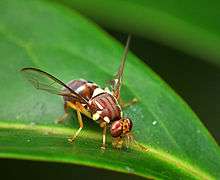Bactrocera tryoni
| Bactrocera tryoni | |
|---|---|
 | |
| Scientific classification | |
| Kingdom: | Animalia |
| Phylum: | Arthropoda |
| Class: | Insecta |
| Order: | Diptera |
| Family: | Tephritidae |
| Subfamily: | Dacinae |
| Tribe: | Dacini |
| Genus: | Bactrocera |
| Species: | B. tryoni |
| Binomial name | |
| Bactrocera tryoni (Froggatt, 1897) | |
| Synonyms | |
| |
The Queensland fruit fly (Bactrocera tryoni) is a species of tephritid fruit fly native to Australia.
Adult flies are about 5 to 8mm in length in adult stage. Their larvae hatch in various fruit species, causing significant damage to crops.[1]
The fly has been the subject of extensive control regimes including a Fruit Fly Exclusion Zone where it is forbidden to take fruit, and post-harvest dipping of fruit in dimethoate and fenthion. As of October 2011, the use of these chemicals was under review by the Australian Pesticides and Veterinary Medicines Authority (APVMA), with dimethoate suspended from use.[2] In May 2012, January 2013 and February 2015 the fly was found in Auckland, posing a risk to horticulture and leading to a quarantine.[3]
Life History
Unlike several of the other most important fruit fly pests, B. tryoni does not breed continuously but passes the winter in the adult stage. The total life cycle requires two to three weeks in summer and up to two months in autumn. Adult females live many months, and four or five overlapping generations may develop annually. Adult females, after passing through a two-week pre-oviposition stage following emergence from the pupae, deposit eggs in groups, up to seven eggs per group, in fruit punctures. Females often oviposit in punctures made by other fruit flies such as those of the Mediterranean fruit fly, Ceratitis capitata (Wiedemann), with the result that many eggs often occur in a single cavity. As many as 40 larvae have been found in one peach, and as many as 67 adults have been reared from one apple. Eggs hatch in two to three days under favorable weather conditions. The ensuing larval development may be completed in as little as five days. Pupation normally occurs in the soil. Pupal development requires from a week in summer to a month or more in cooler weather. Adults may live a year or more. Adults feed primarily upon juices of host plants, nectar, and honeydew secreted by various kinds of insects.
Genomic studies
The genome of B. tryoni has been sequenced and published by a group at the University of New South Wales, Australia . While the coding regions are largely completely sequenced, about one-third of the genome appears to consist of highly repetitive sequences.
The white locus
A gene for white eye found in Drosophila is found to have homologs in this as well as numerous other Diptera.[4]
References
- ↑ Tri-state fruit fly program website
- ↑ Chemical review: dimethoate on APVMA website
- ↑ Chapman, Kate; Robinson, Victoria. "Fly breach blamed on relaxed security". stuff.co.nz. Fairfax Media. Retrieved 13 May 2012.
- ↑ Gomulski, L. M., Pitts, R. J., Costa, S., Saccone, G., Torti, C., Polito, L. C., Gasperi, G., Malacrida, A. R., Kafatos, F. C., Zwiebel, L. J. Genomic Organization and Characterization of the white Locus of the Mediterranean Fruitfly, Ceratitis capitata Genetics 2001 157: 1245-1255 Full text
Further reading
- Courtice, A. C. (2006). Of Peaches and Maggots, The Story of Queensland Fruit Fly. Published by Hillside Books.
External links
- Queensland fruit fly on the UF / IFAS Featured Creatures Web site
- Review of Fruit Fly Management in Victoria and Options for Future Management. Independent review by Kalang Consultancy Services Pty Ltd. for the Department of Primary Industries, Victoria.
- Of Peaches and Maggots: The Story of Queensland Fruit Fly, A.C. Courtice, Hillside Books 2006
- Queensland Fruit Fly:. Department of Agriculture Fisheries and Forestry, Queensland